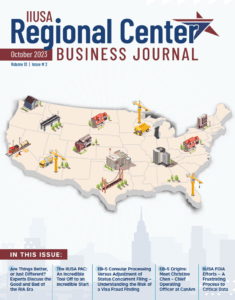 Summary of the July 28, 2016 USCIS EB-5 Stakeholder Engagement
Summary of the July 28, 2016 USCIS EB-5 Stakeholder Engagement
by Cletus M. Weber, Director, IIUSA; Partner, Peng & Weber, PLLC
During the USCIS EB-5 Stakeholder Engagement held on July 28, 2016 in Miami, FL, Immigrant Investor Program Office (IPO) staff provided its quarterly update on the agency’s ongoing struggles to keep up with the ever-growing EB-5 program. In particular, IPO Chief Nicholas Colucci underscored USCIS’s focus on enhancing the transparency and integrity of the regional center program, cautioning that cases of malfeasance by regional center principals threaten to overshadow some of the good things the program is doing. Although self-policing is vital to program integrity, Mr. Colucci said, USCIS would continue to root out bad actors in cooperation with the U.S. Immigration and Customs Enforcement (ICE), Federal Bureau of Investigation (FBI), and the U.S. Securities and Exchange Commission (SEC).
With respect to the impending regional center program sunset on September 30, 2016, Mr. Colucci indicated that Congress is still deliberating the program’s future and that the IPO remains available to provide technical assistance. He also suggested there might be another potential pre-sunset surge in EB-5 petitions and applications (and another slowdown in processing times), similar to the two pre-sunset surges that occurred last September and December. The program’s sunset date was not otherwise a focus of the engagement.
Below is a summary of major topics discussed at the meeting:
Economic Impact of the EB-5 Program
Mr. Colucci disclosed that the U.S. Department of Commerce’s economic impact study of the EB-5 program, which evaluated both regional center and standalone projects that were ongoing in FY 2012 and FY 2013, is undergoing final review and is expected to be released possibly in the next couple of weeks. Hinting at a positive report, he said that “Commerce’s valuation of the program is higher than our [USCIS’s] simplistic straight-line math and it’s also higher than some of the private industry estimates that I’ve seen.”
He noted that the number of regional center designations has swelled from fewer than 200 five years ago to nearly 850 today, and that more than 25,000 EB-5 petitions and applications remain pending currently.
He provided updated filing statistics for FY 2015 through the first half of FY 2016 (i.e., October 1, 2014 to June 30, 2016):
- I-526 petitions received: More than 21,000, representing about $10.5 Billion in potential investment in the U.S. (assuming $500,000 investment per investor)
- I-526 petitions approved: Nearly 11,900 I-526 petitions, representing about $5.9 billion in new capital for new commercial enterprises across the U.S. (assuming $500,000 investment per investor)
- I-829 petitions approved: 2,300, representing 23,000 jobs created across the U.S.
(IIUSA Members: To review the IIUSA’s quarterly data report on I-526 petitions, click here. To review the IIUSA’s quarterly data report on I-829 petitions, click here).
Staffing Updates
Per Mr. Colucci, the IPO hopes to reach its target of 171 staff by the end of calendar year 2016 if not sooner. As of July 28, 2016, there were 142 staff, with 3 more set to come on board in the beginning of August, and 15 or 16 more in the process of coming in. With more staff, IPO was able to reduce pending I-526 petitions by 12% and pending I-924 applications by 8% in the first half of calendar year 2016, although the upcoming regional program sunset is likely to affect processing times going forward. Increased Compliance Activities.
Mr. Colucci elaborated on how USCIS plans to increase regional center compliance:
- Cooperation with federal enforcement agencies. USCIS speaks with ICE and the SEC on at least a weekly basis and will continue working with those agencies and the FBI to vigorously pursue cases of malfeasance.
- Project Site Visits. USCIS Fraud Detection and National Security (FDNS) staff around the country will conduct site visits to job creating enterprises (i.e., projects). The site visits will be mostly unannounced and mostly observational (since workers at a project site might not know enough about EB-5 to engage in a discussion about issues such as job creation). The purpose is see if the project is consistent with what was proposed to USCIS and is operating as expected.
- Regional Center Audits. IPO currently has 2 auditors on board who will conduct audits of regional center activity. These audits will be with notice and follow generally accepted government audit standards. Prior to the audit, IPO will issue an engagement letter announcing the audit and also will likely call the regional center principal to discuss documentation to be reviewed during the audit. IPO will engage with regional center management and staff. The purpose is to determine compliance with the regulations. For example, IPO: 1) will ask about the management and oversight the regional center is conducting on its projects; 2) may follow the path of funds from the immigrant investor into escrow, to the new commercial enterprise, to the JCE; and 3) may look at the JCE’s expenses.
- Expanded I-829 interviews. IPO adjudications division chief Edie Pearson explained that IPO is initiating a new process in which some I-829 petitioners will be interviewed by videoconference. Adjudicators will conduct the interviews from Washington, D.C. to verify information, and IPO understands that limited partners often will not have detailed knowledge of the project.
- Increased interactions with U.S. financial institutions. IPO plans to alert U.S. financial institutions to red flags related to EB-5 filings so they can help identify and report suspicious activity to the U.S. Treasury Department.
- Tips from the public. Mr. Colucci urged stakeholders to report suspected bad actors by contacting USCIS via its website or call the FDNS officer duty line at 202-357-9326.
Regulatory Changes
Both Mr. Colucci and Lori MacKenzie, Chief of IPO’s Policy and Performance Division, cited USCIS’s ongoing work on new EB-5 regulations (which effort is happening concurrently with potential legislative changes by Congress). After thanking stakeholders for feedback that IPO requested in connection with proposed regulatory changes, Ms. MacKenzie confirmed that the EB-5 program is currently on the DHS regulatory agenda without a set time for publication. She said USCIS was legally prohibited from talking about potential regulatory action but indicated that a notice of proposed rulemaking could be expected in the near future. New regulations will likely cover the minimum investment amount, targeted employment areas, the regional center designation process, and indirect job creation methodology-the issues on which IPO previously solicited stakeholder feedback.
Policy Updates
Per Ms. MacKenzie, IPO is in the process of publishing the EB-5 program-related chapter for USCIS’s forthcoming Policy Manual. IPO will first publish its existing policy, and then begin publishing amendments to provide comprehensive guidance on issues that lack clarity under existing policy. These issues including job creation, sustainment of investment, and the impact of misappropriation of funds on those requirements; and regional center terminations and their impact on EB-5 petitioners at various stages of EB-5 process. IPO will release the amendments in draft form for stakeholder comment in the near future, Ms. MacKenzie said.
Other Program Updates
USCIS is in the process of updating the I-924 and I-924A forms and has published proposed changes to the I-526 form for comment. In the coming months, USCIS plans to translate some of the EB-5 content on its website into other languages. Additionally, Congress has approved USCIS’s request for funding to develop a new data system that will enhance USCIS’s ability to analyze and publish EB-5 data.
Q&A Highlight: EB-5 Investors Under 18
As always, the Q&A portion of the engagement covered a wide range of topics, but one of the more interesting questions was whether someone under 18 can submit an I-526 petition as the principal investor. Many regional centers and investors have been asking this question in light of the long EB-5 visa backlog for mainland China-born investors and the increasing likelihood that older children of an investor will age out (turn 21) before visas become available. In response, IPO adjudications division chief David Leckenby addressed whether someone under 18 can submit an I-526 petition as the principal investor. His two main points were as follows:
- Although there is no age limitation under the regulations, a minor normally lacks the legal capacity to enter into the various types of contracts necessary to demonstrate a qualifying EB-5 investment. To overcome the presumptive voidability of such contracts, a minor petitioner bears the burden of proving that the contract he/she entered into or that a guardian entered into on his/her behalf is binding on the minor petitioner. Documents submitted with the I-526 petition of a minor petitioner must include proof of the parent’s/legal guardian’s right to execute offering docs on behalf of minor.
- With regard to the Form I-526, a minor can sign if he/she is age 14 or over, but if under 14, a parent or legal guardian must sign on his/her behalf.
A related question was whether a parent may subscribe for an interest in a new commercial enterprise and subsequently gift the interest to the child. Ms. MacKenzie clarified that such facts would not be sufficient to support an I-526 petition because the child is not the investor.
Overall, the July 2016 EB-5 Stakeholder Engagement reflected an expectation on the part of USCIS that the EB-5 regional center program will continue beyond September 30, 2016, albeit with eventual regulatory, policy, and legislative reforms.
Cletus M Weber is a founding member of Peng & Weber, PLLC, a Seattle-based immigration law firm internationally recognized in EB-5 immigrant investor visas and other US immigration law. Mr Weber serves on the board of directors of Invest in the USA (IIUSA) as well as on the American Immigration Lawyers Association (AILA) EB-5 Committee.








